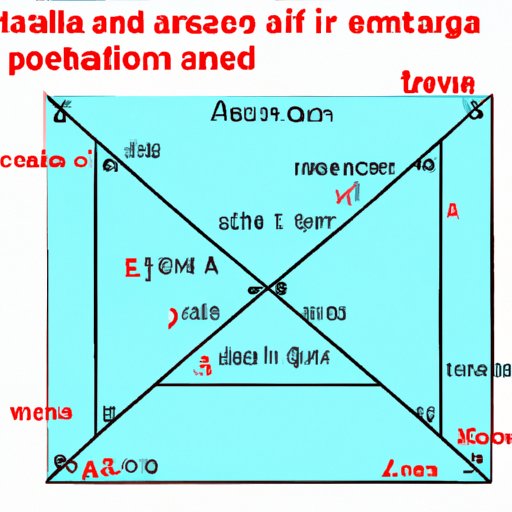
Introduction
Calculating the area of a triangle is a fundamental concept in geometry. It may seem like a simple task, but its real-world applications are vast and varied. Architects, engineers, and designers use this knowledge daily. As a result, understanding how to find the area of a triangle is a crucial skill to have. This article aims to provide a step-by-step guide for calculating the area of a triangle in simple language, as well as explain the historical development of the formula and discuss common mistakes made in the process.
Step-by-Step Guide
The area of a triangle is the region occupied by the triangle in a plane. It is typically measured in square units. To calculate the area of any triangle, follow these easy steps:
Step 1: Identify the Base and the Height of the Triangle
The base of a triangle is the length of the bottom side, while the height is the distance from the base to the opposite vertex. To calculate the area, it is necessary to know the base and the height values.
Step 2: Plug in the Values of the Base and the Height in the Formula
The formula for calculating the area of a triangle is:
Area = (1/2) x base x height
Once you have identified the base and height values, plug them into the formula.
Step 3: Simplify the Expression and Solve for the Area
After substituting the base and height values in the formula, simplify the expression and then solve it to get the area value.
Examples
Let’s calculate the area of the following types of triangles using the above formula:
Simple Triangle:
Consider a triangle of base 2 units and height 3 units:
Area = (1/2) x 2 x 3
Area = 3 square units
Right Triangle:
Consider a right triangle with a base of 10 units and a height of 6 units:
Area = (1/2) x 10 x 6
Area = 30 square units
Isosceles Triangle:
Consider an isosceles triangle with a base of 4 units and a height of 8 units:
Area = (1/2) x 4 x 8
Area = 16 square units
Using visual aids and diagrams will help in clarifying the above examples.
Different Types of Triangles
The formula to calculate the area of a triangle varies depending on the type of triangle. Here are examples of how to find the area of different types of triangles:
Equilateral Triangle:
Consider an equilateral triangle of side ‘a’:
Area = (sqrt(3)/4) x a^2
Obtuse-Angled Triangle:
Consider an obtuse-angled triangle with a base of ‘b’, height ‘h’ and angle ‘C’:
Area = (1/2) x b x h x sin(C)
After identifying the shape of a triangle, use the appropriate formula to calculate its area.
Real-World Applications
The concept of finding the area of a triangle is widely used in many fields, including architecture, engineering, and design.
Architecture:
Architects use this knowledge to calculate the area of floor space in a building to ensure that it is safe and structurally sound.
Engineering:
Engineers use the area formula to determine the necessary materials needed for a project, such as calculating the amount of wire needed to fence land.
Design:
Designers use this concept when creating graphics, such as logos, banners, and other shapes.
Historical Development of the Formula
The formula and concept of calculating the area of a triangle have been used since ancient times, with documented evidence from the Egyptian and Babylonian eras. In the 6th century, the Greek mathematician Thales determined the height of the Pyramids by measuring the length of its shadows and using basic trigonometry to calculate the angle of elevation. Later, Greek mathematicians such as Euclid, Archimedes, and Hero of Alexandria worked on the concept of areas of different shapes, including triangles.
Common Mistakes
Some common mistakes to avoid while calculating the area of a triangle are:
– Using the wrong formula for the type of triangle
– Using the wrong units for base and height
– Misidentifying the base or height of the triangle
Conclusion
Calculating the area of a triangle is an essential concept in geometry and has a wide range of applications in the real world. It is important to understand the formula and different ways to apply it correctly. By following the step-by-step guide and being aware of common mistakes, anyone can master this skill that has been used by mathematicians and scientists for centuries.




